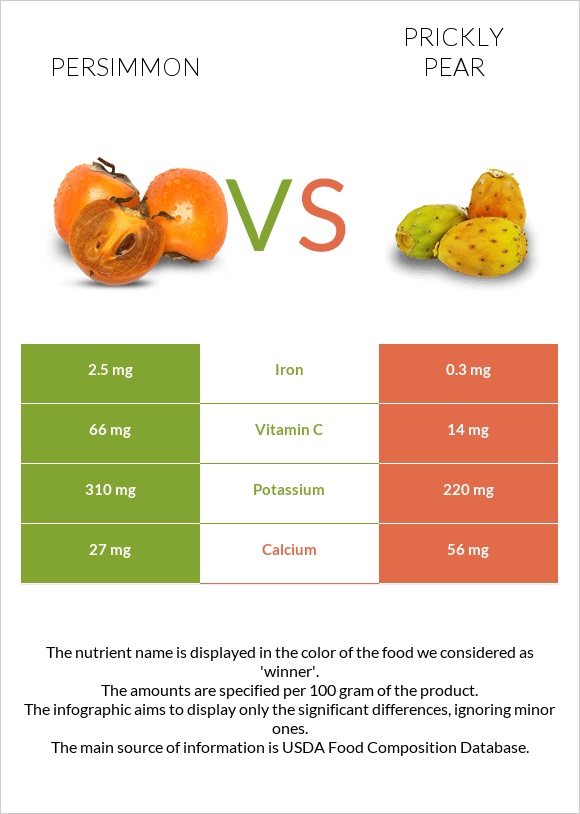Persimmon vs. Prickly pear — In-Depth Nutrition Comparison
Compare
Important differences between persimmon and prickly pear
- Prickly pear has less vitamin C and iron.
- Persimmon's daily need coverage for vitamin C is 58% more.
- Persimmon has 8 times more iron than prickly pear. Persimmon has 2.5mg of iron, while prickly pear has 0.3mg.
- Persimmon has a higher glycemic index than prickly pear.
The food varieties used in the comparison are Persimmons, native, raw and Prickly pears, raw.
Infographic

Infographic link
Mineral Comparison
Mineral comparison score is based on the number of minerals by which one or the other food is richer. The "coverage" charts below show how much of the daily needs can be covered by 300 grams of the food.
| Contains more PotassiumPotassium | +40.9% |
| Contains more IronIron | +733.3% |
| Contains less SodiumSodium | -80% |
| Contains more CalciumCalcium | +107.4% |
Vitamin Comparison
Vitamin comparison score is based on the number of vitamins by which one or the other food is richer. The "coverage" charts below show how much of the daily needs can be covered by 300 grams of the food.
| Contains more Vitamin CVitamin C | +371.4% |
All nutrients comparison - raw data values
| Nutrient |  |
 |
DV% diff. |
| Vitamin C | 66mg | 14mg | 58% |
| Iron | 2.5mg | 0.3mg | 28% |
| Magnesium | 85mg | 20% | |
| Fiber | 3.6g | 14% | |
| Copper | 0.08mg | 9% | |
| Carbs | 33.5g | 9.57g | 8% |
| Vitamin B2 | 0.06mg | 5% | |
| Vitamin B6 | 0.06mg | 5% | |
| Calories | 127kcal | 41kcal | 4% |
| Calcium | 27mg | 56mg | 3% |
| Potassium | 310mg | 220mg | 3% |
| Vitamin B3 | 0.46mg | 3% | |
| Folate | 6µg | 2% | |
| Zinc | 0.12mg | 1% | |
| Selenium | 0.6µg | 1% | |
| Vitamin B1 | 0.014mg | 1% | |
| Polyunsaturated fat | 0.213g | 1% | |
| Protein | 0.8g | 0.73g | 0% |
| Fats | 0.4g | 0.51g | 0% |
| Net carbs | 33.5g | 5.97g | N/A |
| Phosphorus | 26mg | 24mg | 0% |
| Sodium | 1mg | 5mg | 0% |
| Vitamin A | 2µg | 0% | |
| Saturated fat | 0.067g | 0% | |
| Monounsaturated fat | 0.075g | 0% | |
| Tryptophan | 0.014mg | 0% | |
| Threonine | 0.041mg | 0% | |
| Isoleucine | 0.035mg | 0% | |
| Leucine | 0.058mg | 0% | |
| Lysine | 0.045mg | 0% | |
| Methionine | 0.007mg | 0% | |
| Phenylalanine | 0.036mg | 0% | |
| Valine | 0.042mg | 0% | |
| Histidine | 0.016mg | 0% |
Macronutrient Comparison
Macronutrient breakdown side-by-side comparison
Protein:
0.8 g
Fats:
0.4 g
Carbs:
33.5 g
Water:
64.4 g
Other:
0.9 g
Protein:
0.73 g
Fats:
0.51 g
Carbs:
9.57 g
Water:
87.55 g
Other:
1.64 g
| Contains more CarbsCarbs | +250.1% |
| Contains more FatsFats | +27.5% |
| Contains more WaterWater | +35.9% |
| Contains more OtherOther | +82.2% |
~equal in
Protein
~0.73g





